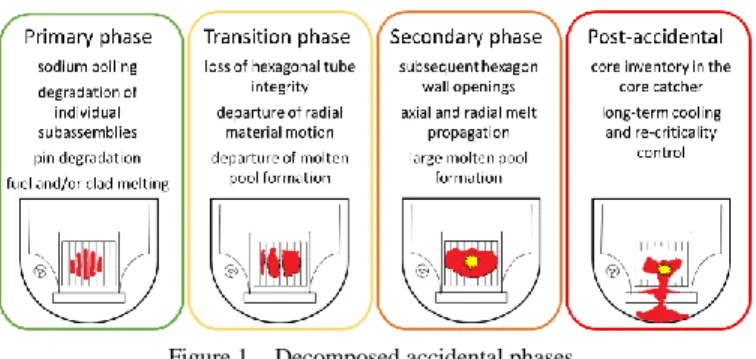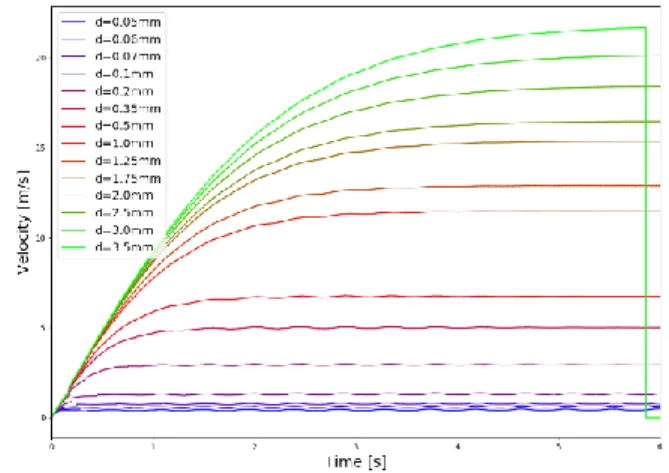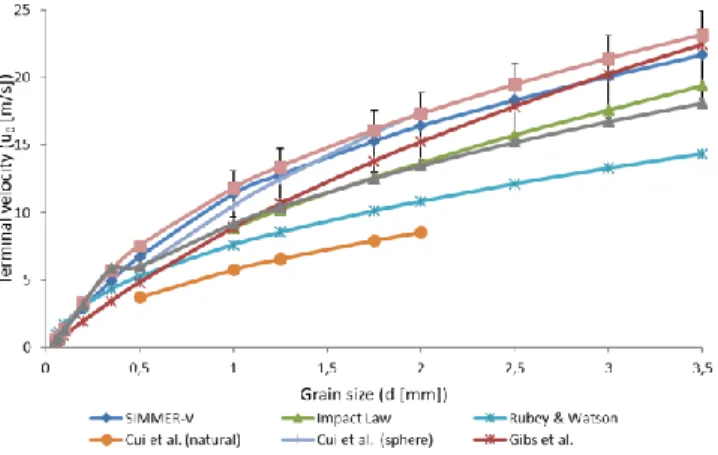HAL Id: cea-02614131
https://hal-cea.archives-ouvertes.fr/cea-02614131
Submitted on 20 May 2020
HAL is a multi-disciplinary open access
archive for the deposit and dissemination of
sci-entific research documents, whether they are
pub-lished or not. The documents may come from
teaching and research institutions in France or
abroad, or from public or private research centers.
L’archive ouverte pluridisciplinaire HAL, est
destinée au dépôt et à la diffusion de documents
scientifiques de niveau recherche, publiés ou non,
émanant des établissements d’enseignement et de
recherche français ou étrangers, des laboratoires
publics ou privés.
Degraded core relocation in Sodium-cooled Fast Reactor
severe accident
− particle-size debris flow
E. Csengeri, A. Bachrata, L. Trotignon, E. Merle
To cite this version:
E. Csengeri, A. Bachrata, L. Trotignon, E. Merle. Degraded core relocation in Sodium-cooled Fast
Reactor severe accident
− particle-size debris flow. IYNC 2020 - International Youth Nuclear Congress,
Mar 2020, Sydney, Australia. �cea-02614131�
Degraded core relocation in Sodium-cooled Fast Reactor severe
accident – particle-size debris flow
E. Csengeri
1, A. Bachrata
2, L. Trotignon
3, E. Merle
41,2
CEA,DEN,DER,SESI, F-13108 Saint Paul lez Durance, France, eszter.csengeri@cea.fr
3CEA,DEN,DTN,SMTA, F-13108 Saint Paul lez Durance, France
4
CNRS,IN2P3,LPSC, F-74019 Annecy-le-Vieux Cedex, France
I. INTRODUCTION
A new generation of nuclear reactors is investigated with the criteria of sustainability, enhanced safety, economics, and proliferation resistance. Among different designs of GEN IV reactors, Sodium-cooled Fast Reactors (SFR) are chosen as reference systems due to the most extensive industrial experience and operational feedback available for this type. Under the research and development of SFR reactors, the domain of severe accident is addressed with high priority in the context of improved safety requirements. In the French frame of SFR safety research, oriented mainly around ASTRID reactor, an innovative severe accident mitigation architecture is being investigated. In this paper, the safety study approach and the mitigation strategy is introduced.
The evaluation of the mitigation performance is currently based on best-estimate calculations with the reference computer code SIMMER. However, uncertainties of SIMMER approach, closely related to the simulation of mitigation scenario and influencing the predicted performance, have been identified. In the second part of the paper, the uncertain modelling area of our interest is described and the first verification & validation of SIMMER are presented.
II. SEVERE ACCIDENT IN SODIUM-COOLED FAST REACTORS The French safety study approach of future generation of SFRs is based on identification of different severe accident families. The families are representative initiating events having the potential to lead to severe core degradation. There are three main categories defined:
• reactivity insertion (unprotected transient overpower, UTOP), • core cooling failure (unprotected loss of flow, ULOF), • local cooling fault accidents (unprotected sub-assembly fault,
USAF).
Each family of sequences can be decomposed into four accidental phases primary, transition, secondary and post-accidental, Figure 1. [1]. The decomposition permits to better follow transient evolution and to point out the driving phenomena.
Figure 1. Decomposed accidental phases.
Over the years of design, manufacturing, commissioning, operation and functioning experience, SFR systems have demonstrated several intrinsic advantages but raised also various problematic areas that still lack the knowledge to resolve. The most crucial aspect regarding the debated safety issue is related to the reactivity characteristic of the sodium-cooled core. Fast reactor cores are not in their most reactive configuration therefore any compaction inserts positive reactivity and enhances the possibility of reaching prompt criticality. Compaction takes place in the transition and secondary phase, when the internal geometry is modified and the relocation of melted core materials is such that dense reactive molten pools may be formed. Prompt criticality induces rapid heating and high pressurization, which disassemble core structures and vaporize fuel and steel components. The resulting large mechanical energy release has the potential to damage reactor vessel and challenges containment integrity. For this reason, core disruptive accidents are treated as major issue in SFR severe accident management .
The purpose of severe accident management is to ensure the safe termination of a postulated core degradation event without any significant radiological release to the environment. It includes the capability of long-term cooling and excludes the occurrence of re-criticalities. It is achieved through maintaining the integrity of the main safety barriers such as main vessel by reducing the possibility and amplitude of power excursions. To comply with this purpose, prevention and mitigation strategies are developed.
III. PREVENTIONANF MITIGATION BY DESIGN In the frame of the French SFR accident prevention, a specific core concept has been developed. The concept applies an upper sodium plena and an axially heterogeneous core that allows a less energetic primary phase due to the favorable sodium void worth characteristics of the core.
Concerning accident mitigation, an innovative strategy is being investigated. It consists of mitigation transfer tubes and a core catcher. The transfer tubes are envisaged to evacuate molten materials from the core center region where there is a potential for the formation of uncool-able reactive molten pools, Figure 2. By limiting the amount of fissile material in the core center region, the transfer tube is dedicated to decrease the probability and amplitude of power excursions. The role of the core catcher is to collect the arriving melt from the transfer tube, facilitate its spreading and provide long-term cooling [2].
Figure 2. The concept of the mitigation transfer tubes. A. Physical phenomenon inside the transfer tube
The transfer tube has the shape of a regular fuel assembly filled with liquid sodium during normal operation. It runs through the whole core, crosses the diagrid, penetrates the strong back and opens to the lower plenum where the core catcher is located.
During a severe accident evolution, the tube starts to perform its function when the neighboring hexagonal walls of surrounding subassemblies lose integrity and allow the containing high temperature molten mixture to touch and eventually melt the surface of the transfer channel. The tube opens to accommodate and guide the entering mixture downwards to the core catcher. The driving forces for the downward vertical material relocation are gravity and pressure. The downward pressure arises from energetic fuel-coolant interactions in which rapid thermal-to-mechanical energy conversion occurs when very high temperature molten fuel or cladding encounters relatively cold liquid sodium. The flow inside the transfer channel is a complex mixture of sodium vapor, solid bodies such as fragmented fuel pellets (3-10 mm) and smaller fuel and steel particles produced from fuel-coolant interaction (typically 0.05 mm), and liquid components such as melted steel and fuel as well as liquid sodium. Complementary to the complexity of the three-phase flow, there can be freezing
or melting and vaporization or condensation of these components along the discharge path. Additional phenomenon related to the interaction between the mixture and the tube wall such as crust formation must be taken into account. Some phenomena, mainly the upward product of FCI, loss of flow mobility due to cooling, freezing, crust formation and the combined effect of them, have the potential to retain the relocation process. Thus, only a part of the entering molten mass may arrive to the lower exit of the tube and being discharged to the core catcher.
The success of the mitigation depends on whether sufficient fraction of fissile material can be evacuated from the core center region. Therefore, it is necessary to estimate the discharge efficiency inside an individual tube. After, the number and position of these tubes can be assessed as well.
IV. NUMERICAL SIMULATION
To evaluate the discharge performance with a high confidence, validated experiments or robust calculation tools can be used. The theoretical demonstration is currently based on best-estimate calculations with the mechanistic reference computer code SIMMER (Sn Implicit Multiphase Multicomponent Eulerian Recriticality). It is an advanced safety analysis computer code dedicated to investigate postulated core disruptive accidents in liquid-metal cooled fast reactors (LMFRs). The fluid-dynamics solution is based on a four-step time factorization time splitting algorithm that solves intra-cell transfers and convection terms in separate calculation steps [3]. SIMMER provides a numerical simulation tool based on mechanistic and physical models for complex multiphase, multicomponent flow problems that are fundamental to core destructive accidents.
Recent simulations of severe accident scenarios with the mitigation strategy have demonstrated, that the discharge of molten and degraded core inventory via a certain number of transfer tubes can be efficient. However, uncertainties of SIMMER approach are identified on the relocation process related to a possible total blockage formation inside the transfer tube due to particle-size debris accumulation. It is believed to originate from the solid particle treatment in the code.
As the material discharge efficiency, and therefore the prediction on reactivity removal, is related to the description on solid particle movement, there is a strong motivation to evaluate the accuracy of particle rich flow modelling in SIMMER. To identify modelling shortcomings, a review of particulate flow description in SIMMER is being performed. A. State-of-the-art SIMMER approach
In SIMMER code, the treatment of particle motion is a user choice. However, the code validation is carried out with specific recommendations. The state-of-the-art description assumes that particles are suspended in their corresponding liquid phase and
they always travel at the same speed as their carrying liquid form. In this approach, the viscosity of a liquid-solid suspension is increased compared to the viscosity the liquid alone, referred as apparent viscosity.
However, the validity of the apparent viscosity model becomes ambiguous when solid particle fraction approaches the maximum packing limit. Maximum packing is the highest density so the largest solid fraction attainable by spherical particles in a given volume. Around this limit, the mixture viscosity is exponentially increased due to the mechanical interlocking of particles, and thus further movement is prevented. In the calculation, flow blockage is observed. Physically, with increasing solid fraction, particle level interactions start to govern the flow characteristics and the repulsive forces may prevent blockage formations. To account for these effects, the assumption on suspended particles may not be the most accurate representation of the physical phenomena. B. Detailed SIMMER approach for partciles
SIMMER, being a multi-velocity-field code, is capable to treat solid fragmented materials as an individual phase by assigning a separate set of balance equations to them. This approach is currently investigated in the French frame of research. In SIMMER, the simplified Navier-Stokes balance equations are uniform for each type of components independent of the phase considered. Our first interest is to focus on the purely dynamic description of particle rich flows, described by the momentum balance equation (1).
𝜕(𝜌𝑣𝑞) 𝜕𝑡 + ∇(𝜌𝑣𝑞𝑣𝑞) + 𝛼𝑞∇𝑝 − 𝜌𝑞𝑔 + 𝐾𝑞𝑠𝑣𝑞 − ∑ 𝐾𝑞𝑞′(𝑣𝑞′− 𝑣𝑞) 𝑞′ − 𝑉𝑀𝑞 = − ∑ Γ𝑞𝑞′ 𝑞′ [𝐻(Γ𝑞𝑞′)𝑣𝑞+ 𝐻(−Γ𝑞𝑞′)𝑣𝑞′] (1)
Itstates that the change of momentum, first term, with time is equal to the net rate of momentum transferred by convection, second term; the acceleration due pressure gradient 𝑝, gravity force 𝑔, drag force of structures 𝐾𝑞𝑠and other components 𝐾𝑞𝑞′; virtual mass force 𝑉𝑀𝑞and the momentum source of newly
created mass Γ𝑞𝑞′. The subscript 𝑞 stands for velocity fields. See
description and units in Appendix.
To evaluate in what contexts this uniform momentum equation is appropriate to account for the specific physics of particulate flows, it is necessary to examine the assumptions behind each term. In this context, the verification of the separate particle momentum approach in SIMMER code is launched. In the verification procedure, reactor scenarios associated to the material discharge via the transfer tubes are analyzed.
V. VERIFICATION OF VERTICAL FLOW OF PARTICLES In reactor severe accident application during the discharge process from the core center zone, situations can develop in which fragmented core materials fall solely by gravitational effects in quasi-stationary surrounding fluid. The description of the purely vertical debris bed sinking in liquid or vapor sodium environment can be related to the concept of terminal velocity. The terminal velocity is a fundamental concept in sediment transport processes. It states that any object moving through a viscous fluid eventually reaches an asymptotic velocity after travelling a critical distance. It is attained when the upward product of buoyancy and drag forces exerted by the surrounding fluid counterbalances the downward gravity force such that the net force on the body becomes zero. The balance of forces brings about zero acceleration leading to a constant rate of motion. The free fall velocity is the highest achievable speed of for the gravity driven motion of suspended particles.
Considering the momentum equation in SIMMER, this scenario is aimed to verify the drag force computed between solid particles and surrounding vapor. The drag force is computed assuming the similarity hypothesis, proposed by [4], for the drag coefficient on spherical bodies. The correlation implemented in the code is written as equation (2) with 𝐶𝐷
being the drag coefficient and 𝑅𝑒 the Reynolds number.
𝐶𝐷= 2.4𝑅𝑒−0.25 (2) To verify the accuracy of SIMMER computed terminal fall velocities, a simple tube filled with vapor and low fraction of solid particles that falling solely by gravity is simulated. Particle diameters are representative to reactor scenarios ranging from 0.05 mm to 3.5 mm, Figure 3.
Figure 3. SIMMER predicted termial velocities as a fucntion of particle size. The curves for each grain size are in agreement with the concept of the terminal velocity. After a certain distance travelled, a constant speed is reached. The balance between the drag and gravity force as a function of grain diameter is such
that higher and more delayed asymptotic velocity is attained for larger grains. Theoretically, there are several empirical and analytical formula proposed to calculate solid’s terminal falling velocity with particle diameter. Physics-based analytical equations for spherical particles include the Stokes and Impact laws. Empirical correlations include Rubey and later modified by Watson, Gibbs et al., Cui et at. and Ferguson ad Church [5]. These expressions with their range of applicability are compared to SIMMER results (taking the asymptotic velocity for each size) of athermal solid particles of changing size falling in a vertical channel filled with vapor.
Figure 4. Comparison of terminal fall velocities.
From the comparison, Figure 4, it is clear that even empirical equations yield a broad range of terminal velocities. The observed large uncertainties arise from the limited opportunities for experimental data synthesis due to the lack of comparison methods. On a global scale, SIMMER results closely follow the curves of Ferguson & Church’s model. Considering 6% r.m.s. error of SIMMER results, the equation of Ferguson & Church verifies the result for each grain size.
VI. CONCLUSIONS AND ORIENTATIONS FOR FUTURE R&D In this paper, due to the importance of solid phase, mainly fuel, relocation during the severe accident mitigation scenario of SFRs, the impact of solid fragment treatment is studied through the SIMMER approach. As it was introduced previously, the particle motion within SIMMER code may be treated by separate balance equations. Although, the uniformity of these equations raises the question whether the specific physics of particle systems is well represented by these simplified Navier-Stokes equations and their closure terms. To evaluate SIMMER solid particle treatment, verification and validation activities have been launched. The first results are presented in this paper.
On the other hand, future R&D work is proposed to improve SIMMER modelling of particles by investigating
granular flow models. Identifying the most prominent features of granular mater, additional terms can be introduced into existing SIMMER equations. Granular theories describe the behavior of large population of discrete macroscopic bodies, which can be associated to solid degraded core materials encountered during the mitigation scenario of SFRs. Granular matter under certain conditions displays similar behavior to solid, liquid and gas, although, the global behavior is different from any other forms of matter. There are different theories developed to describe each regime including the effects of particular granular features. The two essential aspects contributing to the unique properties are the dissipative nature of interactions between grains due to the static friction and inelastic collisions, and that the ordinary temperature plays no role in motion [6]. With the current state of overview, the liquid regime is the most suitable to describe the fragmented material discharge process. It is partially due to the continuum approach that are similar to SIMMER architecture, and thus would facilitate the implementation of the new model. Another reason is the correspondence between the characteristics of granular liquid and the relatively dense, continuously flowing nature of fragmented core materials inside the tube. Future R&D work is oriented towards the theoretical description of this regime. REFERENCES
[1] A. Bachrata, L. Trotignon, P. Sciora, and M. Saez, “A three-dimensional neutronics – Thermalhydraulics Unprotected Loss of Flow simulation in Sodium-cooled Fast Reactor with mitigation devices,” Nuclear
Engineering and Design, vol. 346, pp. 1–9, May 2019.
[2] F. Bertrand et al., “Status of severe accident studies at the end of the conceptual design of ASTRID: Feedback on mitigation features,”
Nuclear Engineering and Design, vol. 326, pp. 55–64, Jan. 2018.
[3] W. Maschek, A. Rineiski, T. Suzuki, X. Chen, M. Mori, and S. Wang, “The SIMMER-III and SIMMER-IV Code Family: 2-D and 3-D Mechanistic Simulation Tools for Reactor Transients and Accidents,” p. 13.
[4] M. Ishii and T. Hibiki, Thermo-Fluid Dynamics of Two-Phase Flow. Springer Science & Business Media, 2010.
[5] E. J. Farrell and D. J. Sherman, “A new relationship between grain size and fall (settling) velocity in air,” Progress in Physical Geography: Earth
and Environment, vol. 39, no. 3, pp. 361–387, Jun. 2015.
[6] H. M. Jaeger, S. R. Nagel, and R. P. Behringer, “Granular solids, liquids, and gases,” Reviews of Modern Physics, vol. 68, no. 4, pp. 1259–1273, Oct. 1996.
APPENDIX
Symbol Meaning Units α Void fraction - g Gravity m/s2 H Heaviside function - ρ Density g/cm3 p Pressure Pa v Velocity m/s



